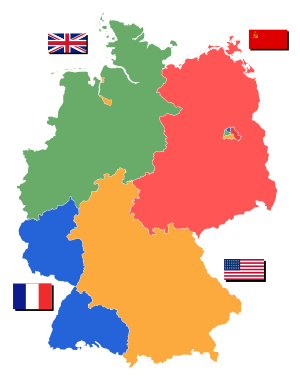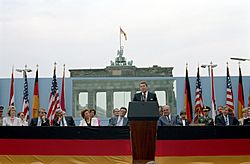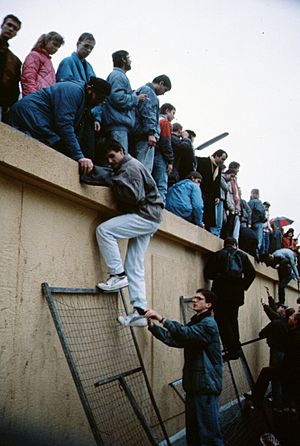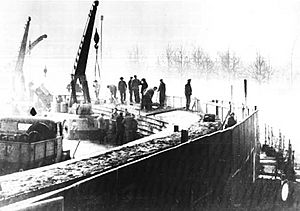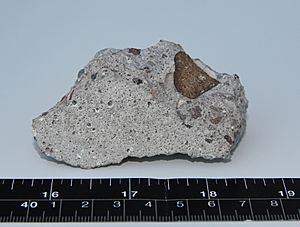Berlin Wall facts for kids
Quick facts for kids Berlin Wall |
|
|---|---|
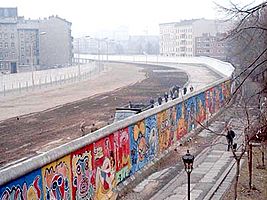
Berlin Wall, with graffiti and death strip. The side with the graffiti on is the West. This was at a street called Bethaniendamm
|
|
| General information | |
| Type | Wall |
| Country | |
| Coordinates | 52°30′58″N 13°22′37″E / 52.51611°N 13.37694°E |
| Construction started | 13 August 1961 |
| Demolished | 9 November 1989 |
| Dimensions | |
| Other dimensions |
|
| Technical details | |
| Size | 155 km (96.3 mi) |
The Berlin Wall (German: Berliner Mauer) was a large wall that divided the city of Berlin in Germany. It stood from 1961 to 1989. The wall separated the eastern part of the city from the western part. Many people saw it as a strong symbol of the Cold War, a time of tension between the United States and the Soviet Union.
The Berlin Wall was torn down on November 9, 1989. It was about 168 kilometres (104 miles) long. Its main purpose was to stop people from leaving the eastern half of Berlin.
Contents
Germany Divided: After World War II
After World War II ended, Germany was split into four areas. Each area was controlled by one of the main Allied countries: France, the United Kingdom, the United States, and the Soviet Union.
Germany's capital city, Berlin, was also divided into four parts. Berlin was like an island inside the Soviet-controlled area.
On May 8, 1949, the areas controlled by France, the UK, and the US became West Germany. The western part of Berlin became West Berlin. The Soviet-controlled areas became East Germany and East Berlin. East Germany was officially founded on October 7, 1949. This division created an "Iron Curtain" that separated Europe, Germany, and Berlin.
Why the Berlin Wall Was Built
After Germany was split into West and East Germany in 1949, many people from East Germany moved to West Germany. About 2.6 million East Germans left their country. In Berlin alone, 3.6 million people moved to the west.
To stop this movement, the Communist government of East Germany built a wall. On August 13, 1961, they started building the wall that separated East and West Berlin.
The government said the wall was to keep out capitalism. But its real purpose was to keep people from leaving East Germany.
Even with the wall, people still tried to escape. They used many clever ways to get past the guards and barbed wire.
The Wall Comes Down
In the late 1980s, Mikhail Gorbachev, the leader of the Soviet Union, announced a big change. He said the Soviet Union would not use its army to stop countries in Eastern Europe from changing their governments.
After this, several countries began to change. Hungary opened its border with Austria. Many people from East Germany started to travel through Hungary to reach West Germany.
In October 1989, large protests against the government began in East Germany. The long-time leader, Erich Honecker, stepped down. He was replaced by Egon Krenz. Honecker had said earlier in 1989 that the wall would last for "a hundred more years." But he was wrong.
In November 1989, East Germany's government decided to make it easier for people to cross the wall. A mistake by a press officer meant the border was opened hours earlier than planned.
Millions of East German citizens celebrated the wall's opening. Many people took pieces of the wall as souvenirs. Television stations showed people hitting the wall with sledgehammers.
Less than a year after the Berlin Wall fell, Germany became one country again.
-
Satellite image of Berlin. The yellow line shows where the Wall was.
Lives Lost at the Wall
During the 28 years the Berlin Wall existed, between 125 and 206 people were killed trying to cross it. Many more died trying to cross from East Germany to West Germany outside Berlin.
The East German government did not record all deaths, so the exact number of people who died may never be known. People caught trying to escape faced at least five years in jail.
The first person to die at the Wall was Ida Siekmann. She was badly hurt after jumping from her apartment window and falling onto the pavement on the west side.
The first person shot while trying to cross was Günter Litfin. He was 24 years old and was shot by police near the Berlin Friedrichstrasse railway station on August 24, 1961. This was just eleven days after the border was closed.
Peter Fechter bled to death in the "death strip" on August 17, 1962. This caused a lot of public anger. American soldiers watched but could not help him. The East German border police who shot him also did not help.
In 1966, two children, aged ten and thirteen, were killed in the border area. This was unusual because border police were told not to shoot pregnant women, children, or mentally ill people.
On February 6, 1989, border guards shot and killed Chris Gueffroy as he tried to cross. He was the last person killed by border guards. On March 8, 1989, Winfried Freudenberg died after falling from a gas balloon. He was the last person to die trying to escape into West Berlin.
Protests and a Famous Speech
People's protests played a big role in the wall's fall. Many people climbed onto the wall or gathered against it.
A famous speech, "Tear down this wall!", was given by United States President Ronald Reagan. He spoke to Soviet leader Mikhail Gorbachev on June 12, 1987. The speech happened at the Brandenburg Gate, close to the Berlin Wall, to celebrate Berlin's 750th anniversary. Many believe his speech helped lead to the wall's destruction.
How the Wall Fell
By late 1989, East Germany was facing many problems, including a struggling economy and large protests. The government in Hungary had already started taking down its border fences with Austria in August 1989.
Because of an agreement, East German citizens could travel to other countries in the Soviet bloc. Many East German tourists used this to escape to the west through Hungary. When Hungary refused East Germany's demand to stop these people, East Germany banned all travel to Hungary. This led to more protests.
Erich Honecker, who had led East Germany since 1971, was forced to resign on October 18, 1989. He was replaced by Egon Krenz. Under Krenz, East Germans could still escape to Hungary through Czechoslovakia.
More and more people were leaving, causing problems between East Germany and Czechoslovakia. So, the Krenz government decided to let people leave directly to the west through border checkpoints in East Berlin.
West German media broadcast this news, causing many East Germans to rush to the border crossings. They demanded to be let through immediately.
The border guards at the checkpoints told people to go home. They had no orders to open the wall that night. As more people arrived, the guards became worried. They started stamping passports of the most determined people. This stamp allowed access to West Berlin, but it also meant giving up East German citizenship. People were shocked when they were not allowed back into East Germany.
The chief guard at one checkpoint called his bosses, trying to understand why so many people thought the wall was opening. By 10:45 PM, it was clear that the guards, who were outnumbered, would not use their weapons. The chief guard gave up and ordered the gates to West Berlin to be opened.
Crowds of East Berliners met West Berliners in a joyful scene. The Berlin Wall had finally fallen. Many people climbed onto the wall near the Brandenburg Gate and began chipping away at it. The East German authorities first tried to stop them with water cannons, but it didn't work. The East German army later climbed the wall to prevent people from standing on it.
The government began tearing down the wall the next day. The fall of the wall destroyed the ruling party of East Germany. Many officials resigned. Less than a year later, on October 3, 1990, East Germany reunited with West Germany.
What the Wall Was Made Of
The Berlin Wall was changed and added to many times. It wasn't just one wall, but a complex system of walls, fences, and other barriers.
Here's what the "border fence" was made of, from east to west:
- A concrete wall or wire fence, about 2–3 meters high.
- A signaling system on the ground that would set off an alarm if touched.
- A contact wire fence with barbed wire, taller than a person.
- In some places, kennels for trained dogs, like German Shepherd Dogs.
- In some places, equipment and trenches to stop vehicles and tanks. These were sometimes removed and later replaced.
- Streets for guards to get supplies and reinforcements.
- Watchtowers (there were 302 in 1989) with searchlights.
- The "death strip." This was an open area where all buildings were torn down, leaving nowhere to hide. Sometimes it had sand to show footprints.
- A metallic fence, then the actual border.
- A concrete wall, 3.75 meters high, which was very hard to climb.
The entire border zone was between 30 and 500 meters wide. The official border began before the first fence. You needed a special permit to enter this area. The real border was about one or two meters in front of the final concrete wall. This meant the entire wall complex was inside East Germany.
The border between East Germany and West Germany (outside Berlin) was also heavily guarded with fences and mines. East Germans needed a special permit to live near this border.
What Remains Today
-
Watchtower, near Potsdam Square.
After Germany reunited on October 3, 1990, the Berlin Wall was mostly torn down. A few parts of the wall still remain, and some sections have become museums.
- Out of 302 watchtowers, 5 are still standing.
- The "Todesstreifen" (death zone) can still be seen in many places. Some are now large areas of undeveloped land, while others have become parks.
- There is a private museum at Checkpoint Charlie, a famous crossing point.
- There is a cemetery near Checkpoint Charlie that remembers the victims of the Wall.
Interesting Facts About the Berlin Wall
- The wall was actually two walls. The area between them was patrolled by dogs and had watchtowers and bright lights to catch anyone trying to cross. Many rabbits lived in this space between the two walls.
- The West side of the Berlin Wall was covered in colorful graffiti. The East side had no graffiti.
- The wall divided Berlin for 10,316 days.
- August 13, 1961, was called "Barbed Wire Sunday" in Germany. East German troops and workers began tearing up streets and putting up barbed wire fences. This happened along the 156 kilometers (97 mi) around West Berlin and the 43 kilometers (27 mi) that divided West and East Berlin.
- On July 19, 1988, Bruce Springsteen played a concert in East Berlin. During the show, he said, "I'm not here for any government. I've come to play rock'n'roll for you in the hope that one day all the barriers will be torn down."
- In 1989, after the wall was torn down, collectors could buy a small piece of concrete for $50. Pieces are still sold today.
- In 1988, some land was swapped between East and West Berlin. A small area called the Lenné triangle (near Potsdamer Platz) became part of West Berlin. A few days later, some environmental protestors fled from West Berlin police into East Berlin over the wall. The East German border guards gave them a meal and sent them back.
Related Pages
Images for kids
-
This part of the Wall's "death strip" had Czech hedgehogs (anti-tank obstacles), a guard tower, and a cleared area in 1977.
-
A line showing where the inner part of the wall once stood on Leipziger Platz, near Potsdamer Platz, in 2015.
-
A segment of the Berlin wall in the Sanctuary of Fátima, Portugal.
-
A "BERLINER MAUER 1961–1989" plaque near Checkpoint Charlie showing where the Wall stood.
-
A display of two sections of the Wall and a "You are leaving" sign at Fort Gordon, Georgia, USA.
-
An exhibition for the 25th anniversary of the Berlin Wall's destruction, located at Potsdamer Platz Arkaden.
See also
 In Spanish: Muro de Berlín para niños
In Spanish: Muro de Berlín para niños


